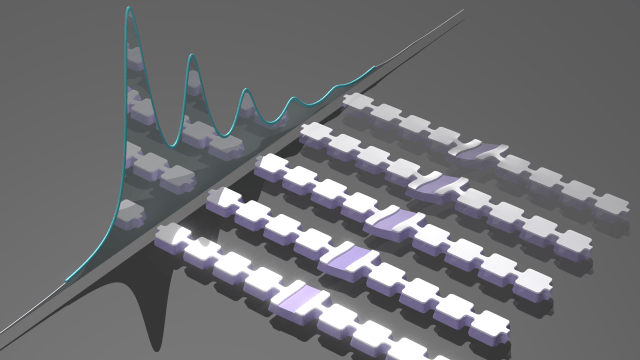A system that can distinguish phonons, the smallest units of sound, marks an important milestone in the development of more advanced quantum computers.
Quantum computers might one day do things difficult or impossible for regular computers to do, but today they’re relatively limited devices. There isn’t usable quantum memory or quantum interfaces between processors, for example. Finding a way to move quantum information between different mediums is therefore of interest to researchers around the world. A team at Stanford has recently published the results of a system that could discern the smallest units of vibration in a tiny oscillator using a quantum bit, an important step toward more advanced quantum computation.
“It was really exciting — we made the measurements on Christmas Eve,” Amir Safavi-Naeini, Stanford University assistant professor of applied physics, told Gizmodo. “[First author Patricio Arrangoiz-Arriola] and I talked about this in 2015 and didn’t know what we were doing, but over a series of papers and measurements really developed it to this point.”
If you don’t know what a quantum computer is or aren’t up to speed on the current state of quantum computing overall, we’ve written a few primers. But basically, if classical computers solve problems by translating them into and crunching them with a system of interacting two-state components called bits, quantum computers solve another set of problems using quantum bits, or qubtis.
Qubits are also two-state components when you measure them, but during the number crunching they can take on an intermediate state between the two choices (with some inherent probability influencing which one you actually measure). They can also entangle such that multiple qubits values’ become more correlated than regular probability would allow, and interfere such that certain combinations of qubit values become more likely and others become forbidden. It’s like if regular computer bits were weighted die, and the values you roll were spookily correlated.
Meanwhile, phonons are individual units of sound or vibrational energy (similar to how photons are individual units of light or electromagnetic energy). Since they’re quantum objects, phonons also follow the rules of quantum mechanics. You can imagine a qubit where its different “states” are represented by the presence of one or two phonons.
It’s especially difficult to resolve these different phonon states — it would require a sort of microphone with more precision than the energy of one phonon. But if scientists were able to make such a microphone, they’d be able to add some important enhancements to quantum computer functionality. If you could convert the information on a qubit into phonons, you might be able to find ways to temporarily store this quantum information, or further convert it into photons to send over a quantum link.
That’s basically what the Stanford researchers were able to show. They constructed tiny oscillators with specially-engineered regions that trapped individual units of energy when the system was held at supercooled temperatures. These oscillators were linked up to superconducting qubits, and then to a readout device. By properly tuning the qubit and the oscillators, the qubit took on a state that matched the oscillator’s state, allowing the researchers to indirectly measure the number of phonons.
This is an important milestone in a field full of researchers trying to figure out ways for superconducting qubits to communicate with mechanical oscillators like this. “They’re able to see the first evidence of this phonon number splitting,” Robert Schoelkopf, director of the Yale Quantum Institute, told Gizmodo. But Schoelkopf pointed out that though there’s a strong relationship between the qubit and the oscillator, this might be at the expense of decoherence time — meaning the system loses its quantum behaviour quickly. Increasing coherence times is of crucial importance to any quantum device.
But should coherence times improve, mechanical oscillators may one day provide important additional functionality to quantum computers. Proposals already suggest using these oscillators as a form of quantum random access memory — actually storing quantum states.
There are already many scientists researching how to transfer quantum data between these oscillators and optical systems, as well as how to connect qubits to electromagnetic components. These mechanical oscillators provide a link between these fields, and could expand the capabilities of future quantum devices.
